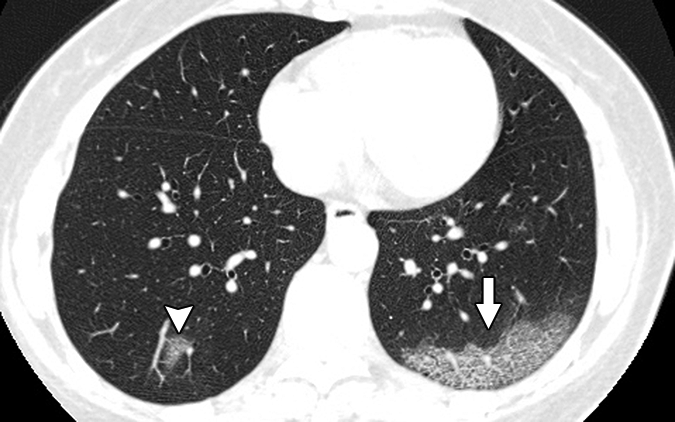Chest CT Can Help Identify COVID-19 Cases in Patients with Initial Negative Tests
Patients who test negative with RT-PCR show lower levels of pulmonary consolidation on chest CT, indicating earlier disease.
CT scans show lower levels of pulmonary consolidation among patients who initially test negative for COVID-19 with the RT-PCR test, but who, ultimately, test positive for coronavirus.
Based on these findings, new research, published Thursday in the American Journal of Roentgenology, highlighted the role that chest CT scans can play in potentially identifying COVID-19-positive patients during the early stage of the disease when the RT-PCR test is at its least reliable.
“The less pulmonary consolidation found at CT, the greater is the possibility of negative initial RT-PCR results,” said a team of researchers from China, led by Dandan Chen of the Guangzhou First People’s Hospital in China. “Chest CT is important in the screening of patients in whom disease is clinically suspected, especially those who have negative initial RT-PCR results.”
To determine how valuable chest CT can be with this patient group, Chen’s team examined CT scans and RT-PCR results from 21 patients admitted to five hospitals located in four districts of Guangzhou, China. The patients were admitted from Jan. 19, 2020, to Feb. 20, 2020, and they were all eventually confirmed with RT-PCR to have COVID-19 infection.
During the study, patients underwent chest CT and mouth swab tests on the same day and underwent RT-PCR tests within three days. Chen’s team divided them into two groups: those with initial positive results (14 patients) and those who initially tested negative (seven patients). Those patients who had initial negative tests did test positive for the virus via a second RT-PCR test two days later.
55-year-old woman who had been in Wuhan and had negative initial reverse transcription–polymerase chain reaction results. A, Axial unenhanced thin-section CT scan shows lesion (arrow) in subpleural region of left lower lung with attenuation of ground-glass opacities, with thickened interlobular septa presenting as typical crazy paving pattern. Ground-glass opacities in right lower lung indicate another small lesion (arrowhead) around bronchus. Courtesy: American Journal of Roentgenology

According to the team’s analysis of the CT scans, 67 percent of the COVID-19 lesions were located in multiple lobes with 72 percent being identified in both lungs. In addition, the investigators visualized several other CT findings frequently:
- Ground-glass opacities (95 percent)
- Consolidation (72 percent)
- Subpleural distribution (100 percent)
Other CT findings included:
- Air bronchogram (57 percent)
- Vascular enlargement (67 percent)
- Interlobular septal thickening (62 percent)
- Pleural effusions (19 percent)
Among study participants who initially tested negative, the chest CT scan show that most lesions appeared as ground-glass opacities or opacities mixed with a small area of consolidation. This indicates early-stage disease, the team explained. And, as the area of consolidation increases, the likelihood of a false-negative result decreases.
“In these cases,” the team said, “chest CT may be considered a primary tool for detection of current COVID-19 in epidemic areas.”
In comparison with the positive initial RT-PCR results group, CT results of the initially negative RT-PCR were less likely to indicate pulmonary consolidation (p=0.04). This outcome, coupled with the knowledge that RT-PCR is less effective in patients who are in initial disease phases, highlighted the potential importance of chest CT, particularly in patients who initially test negative with RT-PCR, the team contended.
“Although CT is not the final standard for the diagnosis of COVID-19 pneumonia, it nevertheless plays an irreplaceable role,” the team said. “When patients with suspected COVID-19 pneumonia who have an epidemiologic history and typical CT features have negative initial RT-PCR results, repeated RT-PCR tests and patient isolation should be considered.”
What is the Best Use of AI in CT Lung Cancer Screening?
April 18th 2025In comparison to radiologist assessment, the use of AI to pre-screen patients with low-dose CT lung cancer screening provided a 12 percent reduction in mean interpretation time with a slight increase in specificity and a slight decrease in the recall rate, according to new research.
The Reading Room: Racial and Ethnic Minorities, Cancer Screenings, and COVID-19
November 3rd 2020In this podcast episode, Dr. Shalom Kalnicki, from Montefiore and Albert Einstein College of Medicine, discusses the disparities minority patients face with cancer screenings and what can be done to increase access during the pandemic.
Can CT-Based AI Radiomics Enhance Prediction of Recurrence-Free Survival for Non-Metastatic ccRCC?
April 14th 2025In comparison to a model based on clinicopathological risk factors, a CT radiomics-based machine learning model offered greater than a 10 percent higher AUC for predicting five-year recurrence-free survival in patients with non-metastatic clear cell renal cell carcinoma (ccRCC).
Could Lymph Node Distribution Patterns on CT Improve Staging for Colon Cancer?
April 11th 2025For patients with microsatellite instability-high colon cancer, distribution-based clinical lymph node staging (dCN) with computed tomography (CT) offered nearly double the accuracy rate of clinical lymph node staging in a recent study.